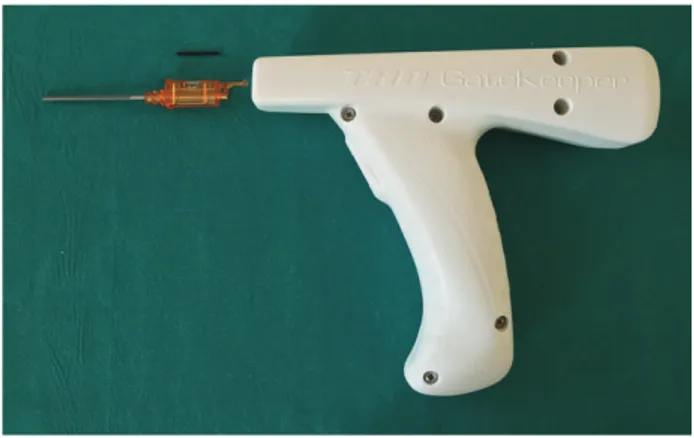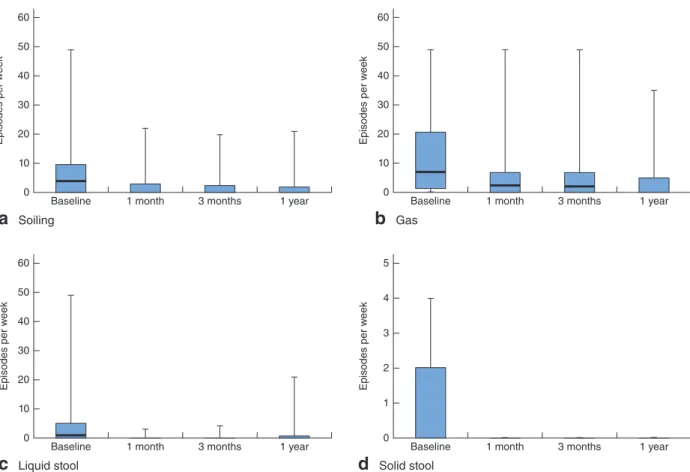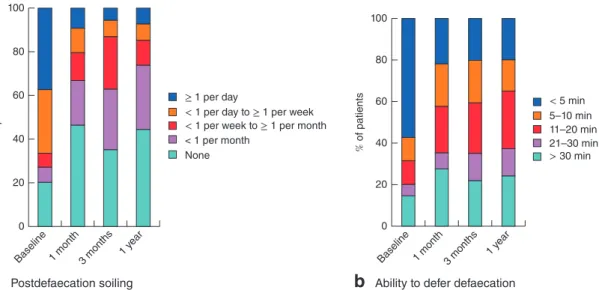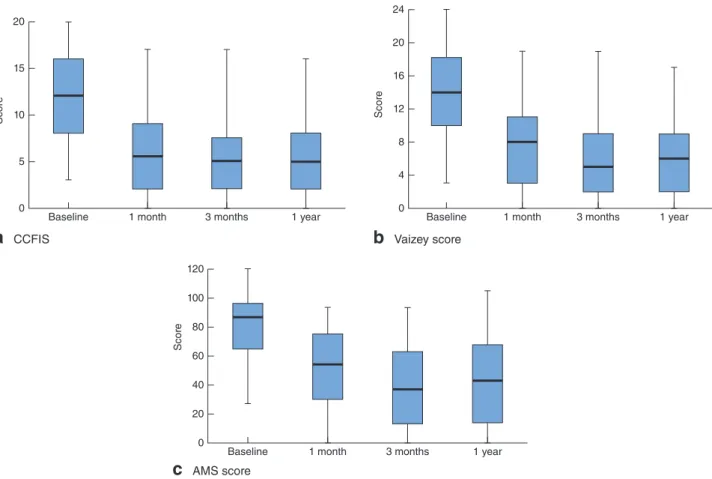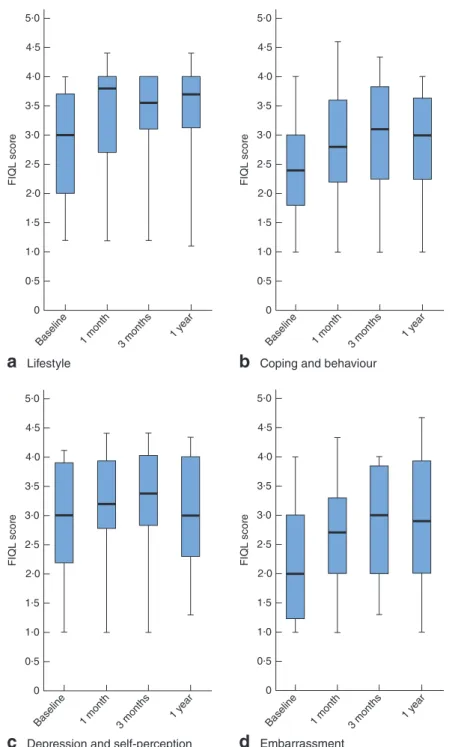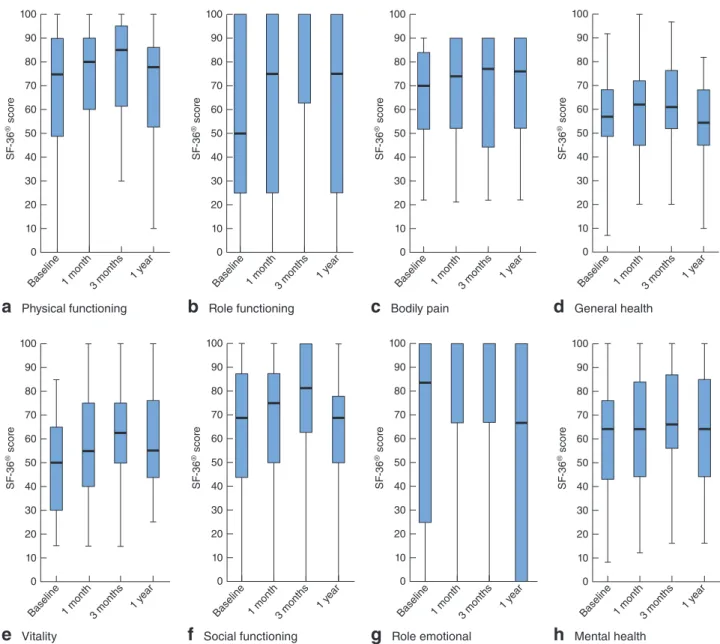Multicentre observational study of the Gatekeeper™ for faecal
incontinence
C. Ratto1, S. Buntzen4, F. Aigner5,6, D. F. Altomare2, A. Heydari3, L. Donisi1, L. Lundby4 and A. Parello1
1Proctology Unit, Department of Surgical Sciences, Catholic University, Rome,2Department of Emergency and Organ Transplantation, General Surgery Unit, University of Bari, Bari, and3Department of General Surgery, Nuovo Ospedale Civile Sant’Agostino Estense, Modena, Italy, 4Department of Surgery P, Aarhus University Hospital, Aarhus, Denmark,5Department of Visceral, Transplant and Thoracic Surgery, Innsbruck Medical University, Innsbruck, Austria, and6Department of General, Visceral and Transplant Surgery, Charité Universitätsmedizin Berlin, Campus Virchow-Klinikum, Berlin, Germany
Correspondence to: Professor C. Ratto, Proctology Unit, Department of Surgical Sciences, Catholic University, Largo A. Gemelli 8, 00165, Rome, Italy (e-mail: [email protected])
Background:A variety of therapeutic approaches are available for faecal incontinence. Implantation of Gatekeeper™ prostheses is a new promising option. The primary endpoint of this prospective observational multicentre study was to assess the clinical efficacy of Gatekeeper™ implantation in patients with faecal incontinence. Secondary endpoints included the assessment of patients’ quality of life, and the feasibility and safety of implantation.
Methods:Patients with faecal incontinence, with either intact sphincters or internal anal sphincter lesions extending for less than 60∘ of the anal circumference, were selected. Intersphincteric implantation of six prostheses was performed. At baseline, and 1, 3 and 12 months after implantation, the number of faecal incontinence episodes, Cleveland Clinic Faecal Incontinence, Vaizey and American Medical Systems, Faecal Incontinence Quality of Life Scale and Short Form 36 Health Survey scores were recorded. Endoanal ultrasonography was performed at baseline and follow-up.
Results:Fifty-four patients were implanted. After Gatekeeper™ implantation, incontinence to gas, liquid and solid stool improved significantly, soiling was reduced, and ability to defer defaecation enhanced. All faecal incontinence severity scores were significantly reduced, and patients’ quality of life improved. At 12 months, 30 patients (56 per cent) showed at least 75 per cent improvement in all faecal incontinence parameters, and seven (13 per cent) became fully continent. In three patients a single prosthesis was extruded during surgery, but was replaced immediately. After implantation, prosthesis dislodgement occurred in three patients; no replacement was required.
Conclusion:Anal implantation of the Gatekeeper™ in patients with faecal incontinence was effective and safe. Clinical benefits were sustained at 1-year follow-up.
The copyright line for this article was changed on 7th January 2016 after original online publication. Paper accepted 7 October 2015
Published online 1 December 2015 in Wiley Online Library (www.bjs.co.uk). DOI: 10.1002/bjs.10050
Introduction
The management of faecal incontinence remains contro-versial, although the use of modern and technologically advanced solutions has recently provided significant improvements. Owing to the multifactorial aetiology of faecal incontinence and the need to mirror a specific pathophysiological mechanism, the choice of appropriate treatment can be extremely challenging. The therapeutic approaches currently available range from non-surgical options, including rehabilitation and biofeedback, to numerous surgical interventions with different levels of
technical complexity1. Among the minimally invasive treatments, injectable bulking agents have been used extensively2–18. However, the results are still controver-sial, resulting in some scepticism and disillusion19–23. In 2011, Ratto and colleagues24 first proposed implantation of the Gatekeeper™ (THD SpA, Correggio, Italy), a self-expandable prosthesis placed into the upper-middle intersphincteric space of the anal canal. Preliminary results24 showed a positive outcome in 14 patients with faecal incontinence.
The present prospective observational international multicentre study was designed with the primary aim of
patients with faecal incontinence. Secondary aims were evaluation of the impact of the surgical procedure on patients’ quality of life (QoL) and health status; assessment of the technical feasibility of the surgical anal implantation of Gatekeeper™ prostheses; evaluation of the safety of the procedure by monitoring intraoperative and postoperative complications; and the displacement of Gatekeeper™ prostheses.
Methods
This was a prospective observational study, involving five European centres. The ethics committees of each participating centre approved the study protocol. Patients selected for the study were informed in detail about aims, procedures and follow-up, and gave written informed consent.
Patient selection and assessment
Patients were enrolled consecutively from a pool of sub-jects with faecal incontinence referred to specialist centres between June 2011 and December 2013. Patient selection was based on data collected from the patient’s history, phys-ical examination, continence diary (recorded for 14 days, including episodes of incontinence to gas, liquid and solid stool, postevacuation soiling episodes, inability to postpone defaecation, and time to postpone defaecation), Cleveland Clinic Faecal Incontinence Score (CCFIS; ranging from 0 to 20)25, Vaizey score (ranging from 0 to 24)26, American Medical Systems (AMS) score (ranging from 0 to 120)27, QoL questionnaires (Faecal Incontinence Quality of Life (FIQL) Scale28 and Short Form 36 (SF-36®
; Quality Metric, Lincoln, Rhode Island, USA) Health Survey29), and endoanal ultrasonography (EAUS). All data were collected prospectively in a specially designed data sheet booklet.
The following selection criteria were used: patients aged between 18 and 80 years; FI onset at least 6 months previ-ously; faecal incontinence episodes (soiling or incontinence to liquid and/or solid stool) occurring more than once a week and resistant to other conservative treatments (phar-macological and behavioural); EAUS evaluation showing intact anal sphincters, or a lesion only of the internal anal sphincter (IAS), with a maximum circumferential extension of 60∘.
Patients were excluded when any of the following cri-teria were encountered: EAUS evidence of an IAS lesion larger than 60∘ or any external anal sphincter (EAS) lesion; previous anal surgery for faecal incontinence (including injection or implantation of another bulking agent); active
Fig. 1Device for THD Gatekeeper™ implantation, including both the delivery system and dispensers in which a single prosthesis is placed
Table 1 Baseline patient characteristics
No. of patients* (n = 54)
Age (years)† 66 (41–80)
Sex ratio (F : M) 37 : 17
Age at onset of FI (years)† 57 (20–78)
Duration of FI (years)† 3 (1–19) Soiling‡ 4 (0–49) Gas‡ 7 (0–49) Liquid stool‡ 1 (0–49) Solid stool‡ 0 (0–49) CCFIS‡ 12 (3–20) Vaizey score‡ 14 (3–24) AMS score‡ 87 (27–120) Urinary incontinence 20
Previous pelvic trauma 4
Previous radiotherapy 5 Diabetes 6 Endocrine disease 12 Neurological disease 2 Gynaecological disease 3 Congenital abnormality 0
*Unless indicated otherwise; values are †mean (range), and ‡median (range) number of episodes per week. FI, faecal incontinence; CCFIS, Cleveland Clinic Faecal Incontinence Score; AMS, American Medical Systems.
perianal sepsis; severe anal scarring; inflammatory bowel disease with anorectal involvement; anal or rectal cancer undergoing active treatment; uncontrolled endocrine, metabolic or neurological disease; congenital anorectal malformation.
Operative procedure
The implantation procedure was performed under local, locoregional or general anaesthesia, with the patient placed in the lithotomy position. Six minimal skin inci-sions (2 mm) were made at 1, 3, 5, 7, 9 and 11 o’clock
Baseline
a
Soilingb
Gasc
Liquid stoold
Solid stool0 10 20 30 Episodes per w eek 40 50 60
1 month 3 months 1 year
Baseline 0 10 20 30 Episodes per w eek 40 50 60
1 month 3 months 1 year 0 Baseline
1 2 3 Episodes per w eek 4 5
1 month 3 months 1 year
Baseline 0 10 20 30 Episodes per w eek 40 50 60
1 month 3 months 1 year
Fig. 2Episodes of a soiling and incontinence to b gas, c liquid stool and d solid stool at baseline and during follow-up after Gatekeeper™ implantation. Median values, interquartile ranges and ranges are denoted by horizontal bars, boxes and error bars respectively. An outlier (49 episodes/week at baseline) has been omitted from d. a–c P< 0⋅001, d P = 0⋅010 (ANOVA)
positions in the perianal area, 2 cm from the anal verge, for the implantation of six Gatekeeper™ prostheses. A specially designed delivery system (THD Gatekeeper™ Delivery System; THD SpA) (Fig. 1) was used during the implantation procedure. The introducer was tunnelled from each skin incision to the intersphincteric margin and introduced into the intersphincteric space. All prosthesis placement steps were checked by digital palpation, direct vision (using the Eisenhammer anal dilator) and EAUS. At the end of the procedure, EAUS was used to show the location of all six prostheses.
Antibiotics were prescribed for 3 days. Patients were advised to avoid any anal trauma and distress, as well as sexual intercourse during the first 48 h after implantation.
Postoperative evaluation and follow-up
Clinical evaluation (including symptoms and physical examination) and EAUS were scheduled 1, 3 and 12 months after surgery. All patients included in the study attended all follow-up appointments, so that none was
lost to follow-up. For each follow-up visit, patients kept a 14-day continence diary, and CCFIS, Vaizey and AMS scores were determined; FIQL and SF-36®questionnaires were also repeated. All adverse events occurring during the follow-up period were recorded.
The clinical success of the Gatekeeper™ was measured using strict criteria, requiring an improvement of 75 per cent or more in all the following faecal incontinence parameters: total number of faecal incontinence episodes per week; number of episodes of soiling per week; num-ber of episodes of incontinence to gas per week; numnum-ber of episodes of incontinence to liquid per week; number of episodes of incontinence to solid stool per week.
Statistical analysis
Data were analysed with SPSS® version 17.0 (IBM, Armonk, New York, USA). Descriptive analysis of patients’ characteristics was performed. To evaluate intraoperative and postoperative complications, and the therapeutic efficacy of the Gatekeeper™ implant on faecal
80 60 % of patients 40 20 0
Baseline 1 month 3 months 1 y ear
≥ 1 per day
< 1 per day to ≥ 1 per week < 1 per week to ≥ 1 per month < 1 per month None 80 60 % of patients 40 20 0
Baseline 1 month 3 months 1 y ear 100 < 5 min 5–10 min 11–20 min 21–30 min > 30 min
a
Postdefaecation soilingb
Ability to defer defaecationFig. 3a Postdefaecation soiling and b ability to defer defaecation at baseline and during follow-up after Gatekeeper™ implantation. a,b
P< 0⋅001 (Friedman test)
Table 2 Number of episodes of soiling and incontinence per week and faecal incontinence severity scores at baseline and during follow-up, in subsets of patients with at least 75 per cent or less than 75 per cent improvement in symptoms of incontinence at 1-year follow-up
Patients with≥ 75% improvement in FI (n = 30) Patients with< 75% improvement in FI (n = 24)
Baseline 1 month 3 months 1 year P* Baseline 1 month 3 months 1 year P*
Soiling 4⋅0 (0–49) 0⋅4 (0–22) 0⋅3 (0–20) 0⋅2 (0–21) < 0⋅001 2⋅5 (0–21) 1⋅5 (0–21) 0⋅8 (0–14) 0 (0–10) 0⋅217 Gas 7⋅0 (0–49) 2⋅5 (0–49) 1⋅0 (0–49) 0 (0–49) 0⋅015 10 (0–40) 2⋅5 (0–35) 5⋅5 (0–35) 0⋅1 (0–35) 0⋅114 Liquid stool 0⋅8 (0–49) 0 (0–3) 0 (0–4) 0 (0–21) 0⋅003 1 (0–20) 0 (0–3) 0 (0–3) 0 (0–4) 0⋅008 Solid stool 0⋅5 (0–49) 0 (0–3) 0 (0–4) 0 (0–21) 0⋅011 0 (0–3) 0 (0–0⋅5) 0 (0–1) 0 (0–7) 0⋅015 CCFIS 13 (3–20) 5 (0–17) 4 (0–19) 4 (0–22) < 0⋅001 9 (3–20) 7 (0–16) 6 (0–16) 5 (1–16) 0⋅002 Vaizey score 15 (3–24) 5 (0–19) 4 (0–19) 4 (0–22) < 0⋅001 12 (5–21) 8⋅5 (0–18) 8⋅5 (0–18) 8 (2–17) 0⋅012 AMS score 94 (28–120) 40⋅5 (0–94) 32 (0–182) 32⋅5 (0–120) < 0⋅001 82 (27–113) 64⋅5 (1–87) 38 (0–80) 59 (1–105) < 0⋅001
Values are median (range). FI, faecal incontinence; CCFIS, Cleveland Clinic Faecal Incontinence Score; AMS, American Medical Systems. *ANOVA.
incontinence, non-parametric tests (χ2 test for trend and Friedman test) were used, with a 95 per cent confidence level. The impact of the surgical procedure on patients’ QoL and health status was evaluated by repeated-measures ANOVA, adjusted for potential co-variables.
Results
Fifty-four patients (17 men and 37 women; median age 66 (range 41–80) years) were enrolled in the study between June 2011 and November 2013. Table 1 shows baseline history, clinical and QoL data. EAUS demonstrated no sphincter injury in 48 patients (89 per cent) and an isolated IAS defect (range 30–60∘) in six (11 per cent).
Clinical efficacy of Gatekeeper™ implant
Fig. 2 shows detailed variations in the median number
of faecal incontinence episodes at different follow-up
stages compared with preimplantation features. The dif-ferences between baseline and follow-up (up to 1 year after Gatekeeper™ implantation) were all statistically significant with respect to incontinence to gas (P< 0⋅001), liquid stool (P< 0⋅001), solid stool (P = 0⋅010) and soiling
(P< 0⋅001). In particular, at baseline 20 patients (37 per
cent) reported soiling at least once a day, but at 1-year follow-up 46 patients (85 per cent) experienced soiling never or less than once a week (Fig. 3a). At baseline, 31 patients (57 per cent) could defer defaecation for less than 5 min, whereas 1 year after Gatekeeper™ implantation 43 patients (80 per cent) had the ability to defer defaecation for at least 5 min (Fig. 3b).
At the final 1-year follow-up, 30 patients (56 per cent) had improvement of at least 75 per cent in all faecal incontinence parameters; among them, seven patients (13 per cent) obtained full anal continence. However, 24 patients (44 per cent) reported less than 75 per cent
Baseline
a
CCFIS 0 5 10 Scor e 15 201 month 3 months 1 year
Baseline
c
AMS score 0 20 40 60 80 Scor e 100 1201 month 3 months 1 year
Baseline
b
Vaizey score 0 4 8 12 Scor e 16 20 241 month 3 months 1 year
Fig. 4Faecal incontinence severity scores at baseline and during follow-up after Gatekeeper™ implantation: a Cleveland Clinic Faecal Incontinence Score (CCFIS), b Vaizey score and c American Medical Systems (AMS) score. Median values, interquartile ranges and ranges are denoted by horizontal bars, boxes and error bars respectively. a–c P< 0⋅001 (ANOVA)
improvement in faecal incontinence parameters at 1-year follow-up. In the subset of patients with at least 75 per cent improvement, soiling and incontinence to gas, liquids and solids were all significantly decreased (Table 2). In the subset of patients with less than 75 per cent improvement, incon-tinence to liquid or solid stools decreased significantly, but differences in soiling and incontinence to gas, even when improved, did not reach statistical significance (Table 2).
All of the scores measuring faecal incontinence severity were reduced significantly throughout follow-up com-pared with baseline values (Fig. 4). Median CCFIS varied from 12 (range 3–20) to 5 (0–16) (P< 0⋅001), median Vaizey score from 14 (3–24) to 6⋅5 (0–17) (P < 0⋅001) and median AMS score from 87 (27–120) to 43⋅5 (range 0–106) (P< 0⋅001). Variations observed after implantation remained stable during the subsequent 12 months. All faecal incontinence severity scores improved significantly in both subsets of patient (Table 2).
Patients’ QoL, as assessed throughout each follow-up stage, was significantly improved for all FIQL
questionnaire items (lifestyle, coping and behaviour, depression and self-perception, and embarrassment) (Fig. 5). Evaluation of the patients’ generic health status (by SF-36® questionnaire) did not show any significant differences at follow-up compared with baseline (Fig. 6).
Feasibility and safety of implantation
All of the procedures were carried out successfully on an outpatient basis. The mean(s.d.) duration of operation was 31⋅0(13⋅4) min. In three patients (6 per cent), a single prosthesis was extruded spontaneously immediately after placement, and was replaced. There were no postoperative complications. In particular, no patient experienced any degree of local or systemic sepsis; seven patients (13 per cent) experienced anal discomfort or pain for 4⋅4(3⋅8) days, requiring administration of non-steroidal anti-inflammatory drugs. In all patients, the pain resolved. Throughout the entire follow-up, neither acute nor chronic inflammation at the prosthesis sites was demonstrated by clinical assessment or EAUS. Patients
Baseline 1 month 3 months 1 y ear
a
Lifestyle 0 1·0 0·5 1·5 FIQL scor e 2·5 3·0 3·5 4·0 4·5 2·0Baseline 1 month 3 months 1 y ear
c
Depression and self-perception 0 1·0 0·5 1·5 FIQL scor e 2·5 3·0 3·5 4·0 4·5 2·0 5·0Baseline 1 month 3 months 1 y ear
d
Embarrassment 0 1·0 0·5 1·5 FIQL scor e 2·5 3·0 3·5 4·0 4·5 2·0 5·0Baseline 1 month 3 months 1 y ear
b
Coping and behaviour 0 1·0 0·5 1·5 FIQL scor e 2·5 3·0 3·5 4·0 4·5 2·0Fig. 5Measurement of patients’ quality of life according to the Faecal Incontinence Quality of Life (FIQL) Scale, at baseline and during follow-up after Gatekeeper™ implantation: a lifestyle, b coping and behaviour, c depression and self-perception, d embarrassment. Median values, interquartile ranges and ranges are denoted by horizontal bars, boxes and error bars respectively. a P = 0⋅010, b,d P = 0⋅001, c P = 0⋅029 (ANOVA)
reported no symptoms at the site of implanted prostheses. Dislodgement of a single prosthesis was documented in three patients (6 per cent), but replacement was not required.
At the 1- and 3-month, and 1-year follow-up, EAUS confirmed that neither acute nor chronic periprosthesis inflammation was present. No patient perceived a significant dislodgement.
Baseline 1 month 3 months 1 y ear
a
Physical functioning 0 20 10 30 SF -36 ® scor e 60 70 80 90 50 40 100Baseline 1 month 3 months 1 y ear
e
Vitality 0 20 10 30 SF -36 ® scor e 60 70 80 90 50 40 100Baseline 1 month 3 months 1 y ear
f
Social functioning 0 20 10 30 SF -36 ® scor e 60 70 80 90 50 40 100Baseline 1 month 3 months 1 y ear
g
Role emotional 0 20 10 30 SF -36 ® scor e 60 70 80 90 50 40 100Baseline 1 month3 months 1 y ear
h
Mental health 0 20 10 30 SF -36 ® scor e 60 70 80 90 50 40 100 Baseline 1 month 3 months 1 year
b
Role functioning 0 20 10 30 SF -36 ® scor e 60 70 80 90 50 40 100Baseline 1 month 3 months 1 y ear
c
Bodily pain 0 20 10 30 SF -36 ® scor e 60 70 80 90 50 40 100Baseline 1 month 3 months 1 y ear
d
General health 0 20 10 30 SF -36 ® scor e 60 70 80 90 50 40 100Fig. 6Measurement of patients’ health status according to the Short Form 36 (SF-36®) questionnaire, at baseline and during follow-up after Gatekeeper™ implantation: a physical functioning, b role functioning, c bodily pain, d general health, e vitality, f social
functioning, g role emotional, h mental health. Median values, interquartile ranges and ranges are denoted by horizontal bars, boxes and error bars respectively. a P = 0⋅488, b P = 0⋅136, c P = 0⋅969, d P = 0⋅348, e P = 0⋅143, f P = 0⋅412, g P = 0⋅348, h P = 0⋅587 (ANOVA)
Despite being prescribed by the protocol, anorectal manovolumetry was performed inconstantly and with dif-ferent methods of investigation. Consequently, the data collected were incomplete and sparse, and could not be interpreted conclusively.
Discussion
The protocol design of the present study was aimed primarily at investigating the efficacy of Gatekeeper™
implantation in the anal canal of patients with faecal incon-tinence. The procedure was used in patients with faecal incontinence with no sphincter lesion or with a very lim-ited IAS gap, where the use of injectable bulking agents is mostly effective. Injectables are usually comprised of microparticles, which are diluted and then injected. This is considered a safe procedure; the adverse events are described to be uncommon, minor and self-limiting, the commonest being proctalgia and/or local pain, local bruis-ing, inflammation, and expulsion of the agent. However,
quite frequently, as demonstrated in a recent study by Guerra and colleagues30, which evaluated 19 patients var-iously ‘injected’ for idiopathic faecal incontinence. These authors found that, on average, only 14 per cent of the originally injected volume was still detectable at EAUS performed at a median follow-up of 7 years, and the clini-cal improvements achieved in the short term had declined significantly.
Indeed, the displacement of bulking agents should be considered as the main cause of the possible progressive decline in therapeutic effect22,23,30. In 2010, a systematic
review21 of the efficacy and safety of injectables for pas-sive faecal incontinence included 14 heterogeneous series (420 patients); the conclusions drawn were not definitive, although the procedure appeared safe and the improve-ments significant. A further systematic review22 analysed 31 published studies and eight meeting abstracts (1070 patients in total). Pooled analysis showed improved con-tinence in 69⋅7 per cent of patients in the postopera-tive period, but in only 45⋅2 per cent at the 12-month follow-up. In 2013, in a Cochrane review23 of five ran-domized studies (all but 1 with uncertain or high risk of bias) that included 382 patients, the authors noted that: ‘No longterm evidence on outcomes was available and further conclusions were not warranted from the available data. None of the studies reported patient evaluation of out-comes and thus it is difficult to gauge whether the improve-ment in incontinence scores matched practical symptom improvements that mattered to the patients’.
In a multicentre trial16, 206 patients were randomized in a 2 : 1 ratio between submucosal injection of dextranomer in stabilized hyaluronic acid gel or sham injection. In the treatment arm, 82⋅5 per cent of patients required a dou-ble injection to stabilize the results. Adverse events were more frequent in the treatment group. At 6 months, 52 per cent of patients obtained at least a 50 per cent reduction in faecal incontinence episodes; however, surprisingly, the sham injection group showed a 31 per cent success rate (P = 0⋅009). Results from 112 of 132 patients in the treat-ment arm were updated in 2014; the same success rate (52 per cent) was observed at the 36-month follow-up, with sig-nificant improvement of both faecal incontinence severity and QoL scores17. La Torre and de la Portilla18 used the same material (dextranomer in stabilized hyaluronic acid gel) in 115 patients with faecal incontinence and an intact EAS. At 24 months, 32 patients were withdrawn from the study, mostly owing to withdrawal of consent (17 patients), reducing the number of those with 24-month follow-up to 83. Of these, 63 per cent were considered responders because they experienced at least a 50 per cent reduction in
documented for both the faecal incontinence severity score and QoL. Although the long-term results from these two series, following the injection of dextranomer in stabilized hyaluronic acid gel, seem interesting, the injectable is com-prised of diluted microparticles, and thus the stability of the material at the site of injection needs to be confirmed. Moreover, in these studies, the success rate was also calcu-lated using the criterion ‘at least 50 per cent reduction in faecal incontinence episodes’, which is of debatable value.
In contrast to the injectables, the Gatekeeper™ consists of solid prostheses of polyacrylonitrile biocompatible material, self-expandable when in contact with body fluids, with a significant increase in prosthetic volume (owing to its highly hydrophilic property), maintaining memory of their shape, without further material deterioration. Prostheses are implanted into the intersphincteric space in a safe and accurate procedure. They attain the increased volume within 48 h, then self-fix in the desired position, preventing, in the vast majority of patients, any significant displacement. Prostheses are clearly visualized and defined by EAUS during both surgical implantation and follow-up. Preliminary results obtained by implanting four pros-theses in 14 patients have highlighted the significant improvement in faecal incontinence episodes, soiling, faecal incontinence severity scores and patients’ QoL, during follow-up approaching 3 years24.
In the present study, patients complained of a high num-ber of episodes of soiling, gas and liquid incontinence. The difficulty of managing this kind of incontinence using the available procedures is well known. The majority of the other therapeutic options (including injectables) usu-ally result in a high proportion of failure, even when using a poor cut-off for success (at least 50 per cent improvement in either faecal incontinence episodes or severity scores)1. However, even when successful, residual soiling or incom-plete control of gas or liquid stool may represent the lead-ing reason for dissatisfaction. In contrast, in the present study, the clinical efficacy of the Gatekeeper™ was investi-gated not by using the usual ‘at least 50 per cent improve-ment’ cut-off of a single parameter, but much stricter cri-teria. The treatment was considered successful only when all of the faecal incontinence parameters reached at least 75 per cent improvement compared with baseline values. This approach in evaluating therapeutic success, even though unusual, is presumed to be much more reliable. In this con-text, obtaining such high performance in the majority of patients (56 per cent had at least 75 per cent improvement, and 13 per cent became fully continent) seems significant. If ‘at least 50 per cent improvement’ had been used as the cut-off for success in the present study, 38 (70 per cent)
of the 54 patients would have been classified as respon-ders. In particular, the detailed patient diaries showed a significant decrease in soiling and all types of faecal inconti-nence; these improvements remained stable over the 1-year follow-up. It is worth highlighting the results for soiling and incontinence to gas and liquid stool, which decreased significantly in the present study (P< 0⋅001).
In patients with at least 75 per cent improvement, all faecal incontinence parameters were statistically improved after Gatekeeper™ implantation. In patients with less than 75 per cent improvement there was improvement in all faecal incontinence parameters, but the differences in soiling episodes and gas incontinence between baseline and follow-up, although relevant, were not statistically significant.
The reduction in soiling and urgency at 1-year follow-up was of particular interest. More than 70 per cent of patients reported postdefaecation soiling never or less than once a month, and 80 per cent could postpone defaecation for at least 5 min. These findings could be regarded as demonstrating a reacquired capacity to contrast sudden or not-perceived leakage of faecal material and to sustain the stimulus to defaecate long enough to reach the toilet.
As a consequence of these features, faecal incontinence improvement was demonstrated by the significantly lower median values of all the severity scores throughout the follow-up. Moreover, the Gatekeeper™ had a significantly positive impact on the patients’ QoL. In this study, the SF-36®questionnaire was administered to patients, which provides information on patients’ generic health status rather than on their QoL specifically related to faecal incontinence. Therefore, the lack of significant differences between baseline and follow-up following Gatekeeper™ implantation is not surprising.
This study also investigated other aspects of Gatekeeper™ implantation. The operative procedure was safe, with no local sepsis or chronic inflammation. Intraoperative displacement was rare and managed easily by immediate prosthesis replacement. EAUS was a reliable method for determining accurate implantation, and for patient follow-up. Owing to these features, and because of their intrinsic structural characteristics, Gatekeeper™ prostheses should not be considered as bulking agents any longer, unlike the injectable agents. Unfortunately, even though anorectal manovolumetry was included in the protocol, the data recorded were too sparse and incomplete to draw any reliable conclusions in this regard.
This study has shown the clinical benefits of Gatekeeper™ implantation, which provided a signifi-cant reduction in faecal incontinence episodes, sustained until 12 months after surgery. The surgical procedure was
accurate and performed safely, using a minimally inva-sive approach. Further research should investigate wider indications for this innovative therapeutic option, using different spatial configurations and sizes of implants.
Acknowledgements
The authors thank S. Pitoni for helping with the language revision of the manuscript.
Disclosure: The authors declare no conflict of interest.
References
1 Van Koughnett JA, Wexner SD. Current management of fecal incontinence: choosing amongst treatment options to optimize outcomes. World J Gastroenterol 2013; 19: 9216–9230.
2 Shafik A. Polytetrafluoroethylene injection for the treatment of partial fecal incontinence. Int Surg 1993; 78: 159–161. 3 Shafik A. Perianal injection of autologous fat for treatment
of sphincteric incontinence. Dis Colon Rectum 1995; 38: 583–587.
4 Kumar D, Benson MJ, Bland JE. Glutaraldehyde cross-linked collagen in the treatment of faecal incontinence. Br J Surg 1998; 85: 978–979.
5 Malouf AJ, Vaizey CJ, Norton CS, Kamm MA. Internal anal sphincter augmentation for fecal incontinence using injectable silicone biomaterial. Dis Colon Rectum 2001; 44: 595–600.
6 Davis K, Kumar D, Poloniecki J. Preliminary evaluation of an injectable anal sphincter bulking agent (Durasphere) in the management of faecal incontinence. Aliment Pharmacol Ther 2003; 18: 237–243.
7 Ganio E, Marino F, Giani I, Luc AR, Clerico G, Novelli E et al. Injectable synthetic calcium hydroxylapatite ceramic microspheres (Coaptite) for passive fecal incontinence. Tech Coloproctol 2008; 12: 99–102.
8 Stojkovic SG, Lim M, Burke D, Finan PJ, Sagar PM. Intra-anal collagen injection for the treatment of faecal incontinence. Br J Surg 2006; 93: 1514–1518.
9 de la Portilla F, Fernández A, León E, Rada R, Cisneros N, Maldonado VH et al. Evaluation of the use of PTQ implants for the treatment of incontinent patients due to internal anal sphincter dysfunction. Colorectal Dis 2008; 10: 89–94. 10 Tjandra JJ, Lim JF, Hiscock R, Rajendra P. Injectable
silicone biomaterial for fecal incontinence caused by internal anal sphincter dysfunction is effective. Dis Colon Rectum 2004; 47: 2138–2146.
11 Chan MK, Tjandra JJ. Injectable silicone biomaterial (PTQ) to treat fecal incontinence after hemorrhoidectomy. Dis Colon Rectum 2006; 49: 433–439.
12 van der Hagen SJ, van Gemert WG, Baeten CG. PTQ implants in the treatment of faecal soiling. Br J Surg 2007;
perianal silicone injection for faecal incontinence. Colorectal Dis 2007; 9: 357–361.
14 Siproudhis L, Morcet J, Lainé F. Elastomer implants in faecal incontinence: a blind, randomized placebo-controlled study. Aliment Pharmacol Ther 2007; 25: 1125–1132. 15 Tjandra JJ, Chan MK, Yeh HC. Injectable silicone
biomaterial (PTQ) is more effective than carbon-coated beads (Durasphere) in treating passive faecal
incontinence – a randomized trial. Colorectal Dis 2009; 11: 382–389.
16 Graf W, Mellgren A, Matzel KE, Hull T, Johansson C, Bernstein M; NASHA Dx Study Group. Efficacy of dextranomer in stabilised hyaluronic acid for treatment of faecal incontinence: a randomised, sham-controlled trial. Lancet 2011; 377: 997–1003.
17 Mellgren A, Matzel KE, Pollack J, Hull T, Bernstein M, Graf W; Nasha Dx Study Group. Long-term efficacy of NASHA Dx injection therapy for treatment of fecal incontinence. Neurogastroenterol Motil 2014; 26: 1087–1094. 18 La Torre F, de la Portilla F. Long-term efficacy of
dextranomer in stabilized hyaluronic acid (NASHA/Dx) for treatment of faecal incontinence. Colorectal Dis 2013; 15: 569–574.
19 Maeda Y, Vaizey CJ, Kamm MA. Pilot study of two new injectable bulking agents for the treatment of faecal incontinence. Colorectal Dis 2008; 10: 268–272.
20 Vaizey CJ, Kamm MA. Injectable bulking agents for treating faecal incontinence. Br J Surg 2005; 92: 521–527.
21 Luo C, Samaranayake CB, Plank LD, Bissett IP. Systematic review on the efficacy and safety of injectable bulking agents
296–303.
22 Hussain ZI, Lim M, Stojkovic SG. Systematic review of perianal implants in the treatment of faecal incontinence. Br J Surg 2011; 98: 1526–1536.
23 Maeda Y, Laurberg S, Norton C. Perianal injectable bulking agents as treatment for faecal incontinence in adults. Cochrane Database Syst Rev 2013; (2)CD007959. 24 Ratto C, Parello A, Donisi L, Litta F, De Simone V,
Spazzafumo L et al. Novel bulking agent for faecal incontinence. Br J Surg 2011; 98: 1644–1652.
25 Jorge JM, Wexner SD. Etiology and management of faecal incontinence. Dis Colon Rectum 1993; 36: 77–97.
26 Vaizey CJ, Carapeti E, Cahill JA, Kamm MA. Prospective comparison of faecal incontinence grading systems. Gut 1999; 44: 77–80.
27 American Medical Systems (AMS). Fecal Incontinence Scoring System. AMS: Minnetonka; 1996.
28 Rockwood TH, Church JM, Fleshman JW, Kane RL, Mavrantonis C, Thorson AG et al. Fecal Incontinence Quality of Life Scale: quality of life instrument for patients with fecal incontinence. Dis Colon Rectum 2000; 43: 9–16.
29 Ware JE Jr, Sherbourne CD. The MOS 36-item short-form health survey (SF-36). I. Conceptual framework and item selection. Med Care 1992; 30: 473–483.
30 Guerra F, La Torre M, Giuliani G, Coletta D, Amore Bonapasta S, Velluti F et al. Long-term evaluation of bulking agents for the treatment of fecal incontinence: clinical outcomes and ultrasound evidence. Tech Coloproctol 2015; 19: 23–27.
